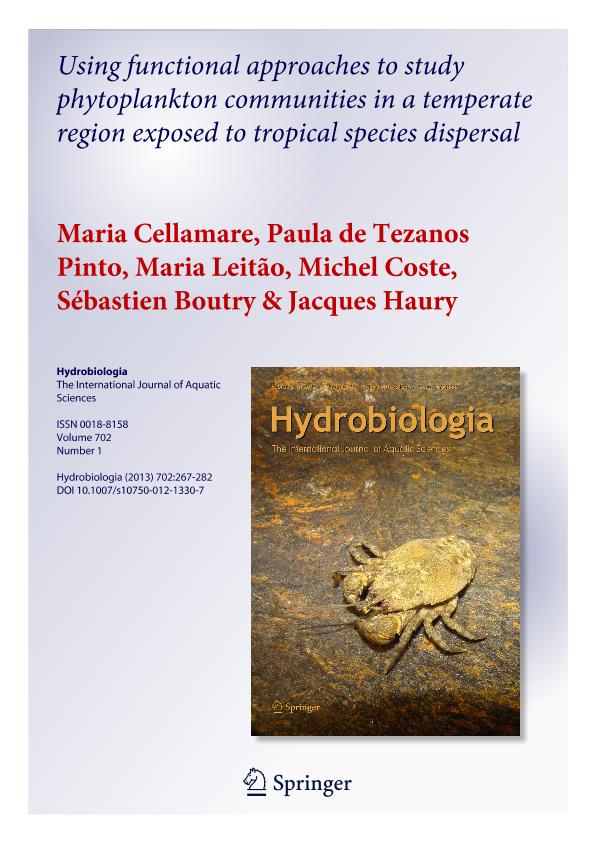Mostrar el registro sencillo del ítem
dc.contributor.author
Cellamare, Maria
dc.contributor.author
de Tezanos Pinto, Paula

dc.contributor.author
Leitao, Maria
dc.contributor.author
Coste, Michel
dc.contributor.author
Boutry, Sebastien
dc.contributor.author
Haury, Jacques
dc.date.available
2017-07-17T16:32:07Z
dc.date.issued
2012-10
dc.identifier.citation
Cellamare, Maria; de Tezanos Pinto, Paula; Leitao, Maria; Coste, Michel; Boutry, Sebastien; et al.; Using functional approaches to study phytoplankton communities in a temperate region exposed to tropical species dispersal; Springer; Hydrobiologia; 702; 1; 10-2012; 267-282
dc.identifier.issn
0018-8158
dc.identifier.uri
http://hdl.handle.net/11336/20692
dc.description.abstract
Functional characteristics play an important role in shaping phytoplankton distributions. This approach can help to explain the success of tropical taxa in temperate ecosystems. We used functional groups (FG) and functional traits (FT) to assess the phytoplankton distribution in five temperate lakes exposed to tropical taxa dispersal. We ran redundancy analyses to assess the relationship between each functional classification and the environment. Both approaches showed similar variance of the phytoplankton biomass and responded to similar environmental variables. The FG approach separated lakes by trophic status (total phosphorus: TP), while the FT approach reflected the lakes’ hydromorphology (conductivity, depth, mixing regime). The traits of motility and mixotrophy coincided with low mixing and high light. Tropical taxa were dominant in two lakes, rare in one and absent in two lakes. When dominant, tropical taxa exerted an overwhelming effect on phytoplankton biomass and community composition, and contributed to foam occurrences. The success of tropical taxa in only two lakes seems related to the interplay of their traits (accessory pigments, morphology) and the prevailing environmental filters (low light, deep mixing, and intermediate TP). Their rarity or absence in the other lakes evidences how traits can increase fitness in one environment but not in other.
dc.format
application/pdf
dc.language.iso
eng
dc.publisher
Springer

dc.rights
info:eu-repo/semantics/openAccess
dc.rights.uri
https://creativecommons.org/licenses/by-nc-sa/2.5/ar/
dc.subject
Phytoplancton
dc.subject
Functional Groups
dc.subject
Functional Traits
dc.subject
Tropical Taxa
dc.subject.classification
Biología Marina, Limnología

dc.subject.classification
Ciencias Biológicas

dc.subject.classification
CIENCIAS NATURALES Y EXACTAS

dc.title
Using functional approaches to study phytoplankton communities in a temperate region exposed to tropical species dispersal
dc.type
info:eu-repo/semantics/article
dc.type
info:ar-repo/semantics/artículo
dc.type
info:eu-repo/semantics/publishedVersion
dc.date.updated
2017-07-05T15:01:06Z
dc.identifier.eissn
1573-5117
dc.journal.volume
702
dc.journal.number
1
dc.journal.pagination
267-282
dc.journal.pais
Países Bajos

dc.journal.ciudad
Dordrecht
dc.description.fil
Fil: Cellamare, Maria. Institut national de recherche en sciences et technologies pour l'environnement et l'agriculture ; Francia
dc.description.fil
Fil: de Tezanos Pinto, Paula. Consejo Nacional de Investigaciones Científicas y Técnicas. Oficina de Coordinación Administrativa Ciudad Universitaria. Instituto de Ecología, Genética y Evolución de Buenos Aires. Universidad de Buenos Aires. Facultad de Ciencias Exactas y Naturales. Instituto de Ecología, Genética y Evolución de Buenos Aires; Argentina
dc.description.fil
Fil: Leitao, Maria. Bi-Eau ; Francia
dc.description.fil
Fil: Coste, Michel. Institut national de recherche en sciences et technologies pour l'environnement et l'agriculture ; Francia
dc.description.fil
Fil: Boutry, Sebastien. Institut national de recherche en sciences et technologies pour l'environnement et l'agriculture ; Francia
dc.description.fil
Fil: Haury, Jacques. Institut National de la Recherche Agronomique; Francia
dc.journal.title
Hydrobiologia

dc.relation.alternativeid
info:eu-repo/semantics/altIdentifier/doi/http://dx.doi.org/10.1007/s10750-012-1330-7
dc.relation.alternativeid
info:eu-repo/semantics/altIdentifier/url/https://link.springer.com/article/10.1007%2Fs10750-012-1330-7
Archivos asociados
